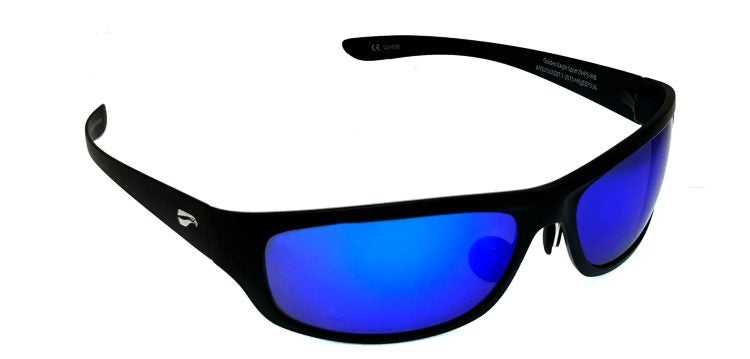These days, photochromatic helmet shields (that change their tint based on the brightness of ambient light) and drop-down internal sunshields are very common on higher-end helmets, and of course tinted shields have been around forever. However, these options are not available for or included with every helmet on the market. For that reason, many riders wear sunglasses while riding. But not all sunglasses fit inside a motorcycle helmet well, which is where Flying Eyes’ lineup of sunglasses comes in. Their flexible frames are designed to easily fit inside a helmet. I first saw them at AIMExpo and after that show, they sent me some test glasses to try.
Flying Eyes sent me three sets of their glasses: the Kingfisher, the Osprey and the Luzon glasses. The Kingfisher and Osprey are Wayfarer-style frames and the Luzons are made for prescription lenses (they sent them to me with demo lenses, since I don’t wear prescription lenses). The first two sets of glasses come with a soft bag and a semi-rigid, zippered foam case. The Luzon frames have a classy leather-look case and a separate flat case that holds the detachable shaded lenses. Flying Eyes offers a wide range of lens tints; they recommend non-polarized lenses for riding wear. The Osprey glasses came with a green-tinted non-polarized lenses and matte black frame; the Osprey glasses came with copper-tinted polarized lenses and a tortoiseshell frame. The Luzon glasses came with matte black frame and the detachable sunglasses lenses had a red mirrored finish.

The pre-curved frames of the Flying Eyes glasses, and their flexible 1mm-thick material, make them very comfortable under a helmet. Photo: Zac Kurylyk
I have been wearing the Kingfisher and Osprey glasses for the past few months while both driving and riding. I’ve done thousands of miles with them. Here are some observations:
The flexible frames are both comfortable and convenient
I’ve worn all sorts of sunglasses in my motorcycle helmets over the years, and found that rigid frames would often fit awkwardly. Because they were stiff, they’d get pushed into the wrong position by helmet padding. The Flying Eyes frames’ flexibility made them better fit my head and the contours of my helmet. And because there is a slight hook at the end of the frame arms, they are a bit more secure than my old American Optical aviators (I wore the classic AOs with their straight arms as motorcycle sunglasses for years).
The flexible frame arms also mean that if you throw these glasses into your tankbag or your jacket pocket inside their soft baggie case, you don’t have to worry about them getting bent out of shape. Alas, my old AO glasses, robust as they were, got beat up by such treatment after a few years. You could break the Flying Eyes glasses through carelessness, but it would be hard to bend them.

The Osprey glasses. Basically, Wayfarer-style glasses made to fit into a motorcycle helmet. Photo: Zac Kurylyk

The Kingfisher glasses. I got these with polarized lenses and liked the glare reduction, but they did occasionally have distortion when the light caught them funny behind my helmet’s shield. Nothing unsafe, but some people wouldn’t like it. Photo: Zac Kurylyk
Flying Eyes says their frames are made of “Micro-thin Resilamide.” I’m not sure if that’s a proprietary material, but bendy eyeglass frames have been on the market a while under other names. What I really liked about Flying Eyes’ frames was their thin form factor. At only 1mm thick, they didn’t take up much space inside my helmets, or dig into my head. Plus, they’ve been designed to fit inside a narrow helmet eye opening. If you’ve ever had big-frame sunglasses that were too bulky to fit in a helmet, you’ll understand why this is a good thing.
The frames come with a lifetime warranty, and you can get them in just about any popular style you want (wraparounds and aviators are also available).
Flying Eyes recommends non-polarized lenses
I’m no sunglasses-ologist, but I can see the difference between crappy shades and a medium-quality set. I have yet to drop truly high-level coin on sunglasses, but my AOs, my Wiley-X aviators and my Native fishing glasses were miles and miles ahead of their Wal-Mart equivalents. I can’t speak to the entire line of Flying Eyes’ glasses, but the ones I had were certainly better than the Wal-Mart shades, and the non-polarized Osprey lenses cut the sun better than my old AO non-polarized AO lenses. As for the polarized Kingfisher lenses, I’d put them roughly on-par with the Revant replacement lenses I have in my Wiley-X glasses, but the clarity is not as good as the pre-Luxottica lenses from Native (I don’t have a pair made since their buyout, so I can’t compare to those lenses, but the pre-buyout Native lenses had amazing clarity for driving, even in low-light conditions).

The flexible frames mean these sunglasses are easy to carry inside your jacket pocket as well. Photo: Zac Kurylyk
In other words: I think the impact-resistant polycarbonate lenses that Flying Eyes uses are middle-of-the-road quality. Because they’re not glass, I think that you might expect it’s easier to scratch them, but if you take care of them, that’s less of an issue. However, remember that if you ride with your helmet’s shield open, you will get bugs hitting your glasses. Sooner or later, they’ll beat up your lenses as a result. For that reason, I generally wore my helmet’s shield in the down or partway-down position while wearing these lenses.
As said earlier, Flying Eyes recommends non-polarized lenses for riding use:
Polarized lenses aren’t recommended for motorcycles due to increased difficulty in seeing other vehicles or road obstructions. We recommend solid tint lenses to provide full shade coverage for motorcycling and other motorsports.
Our Mirrored Rose lens is an excellent choice for a high-contrast, rose-tinted lens that helps you see road obstructions and other motorists.
I don’t know if that’s a real danger, but I do note that the polarized lenses can make for a bit of a wonky visual distortion when you’re wearing them under the helmet shield in the flipped-down position. I think I prefer the non-polarized lenses, having used both sets for many miles this year.

Flying Eyes will sell you sunglasses in all sorts of styles. Photo: Zac Kurylyk
Flying Eyes’ lenses come with a one-year warranty. You can buy replacement lenses directly through their webstore; it appears pricing starts around $100.
Are they for you? It depends
These sunglasses make your life more comfortable on the road. They fit nicely in your helmet, and they are built to last for miles. But they’re quite pricey, with an MSRP that starts around $317 in the US.
For me personally, that would probably rule them out, if I was buying a set of glasses specifically for wearing on the bike. I’m not saying they’re not worth it—I’m saying I’m too cheap, and I rarely wear sunglasses while riding.
However, lots of people do wear sunglasses while riding, and I think that if you’re the kind of rider who likes comfort on the road, then maybe you’d be interested in trying out one of Flying Eyes’ fit kits, at least (see more info here).

A nice, comfortable option for riders who want something to wear with their helmet. Photo: Zac Kurylyk
I think this is especially for the Luzon frames. If you wear prescription eyeglasses every day, it would sure be nice to have a set that was made to wear under a moto helmet, and having a set of detachable sunglasses lenses (they’re held in place by a magnet) would be even better. Check back with me in a decade; I’m sure I’ll need glasses by then, and have more thoughts on this design…
In closing: I’m neither recommending these frames to you, nor am I urging you to stay away. But they’re an option worth knowing about, and if you can get your hands on a pair in-person, they might make your riding life a lot more comfortable.
For a full look at their lineup, visit FlyingEyesOptics.com.







